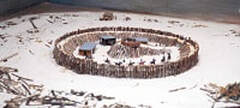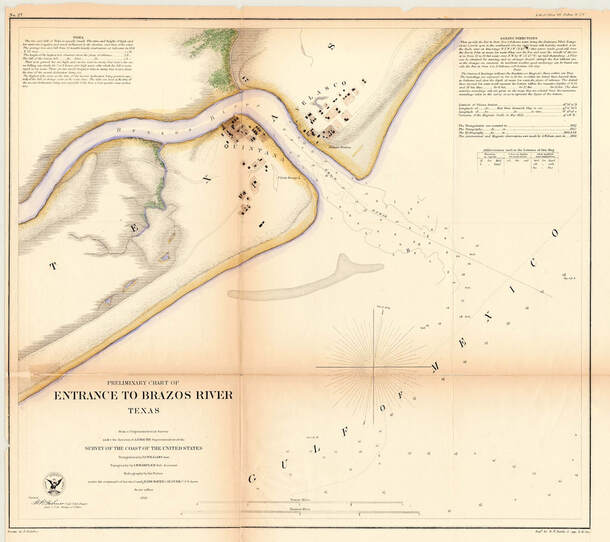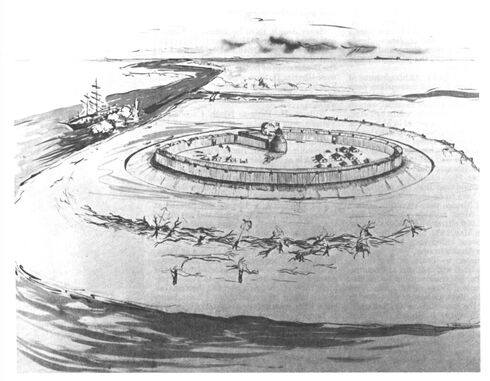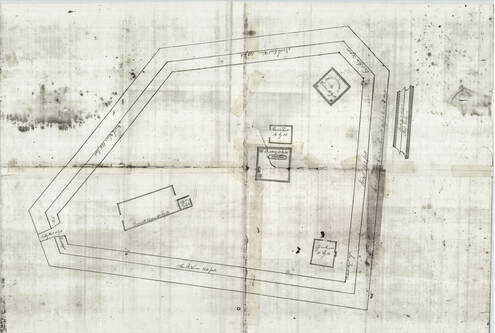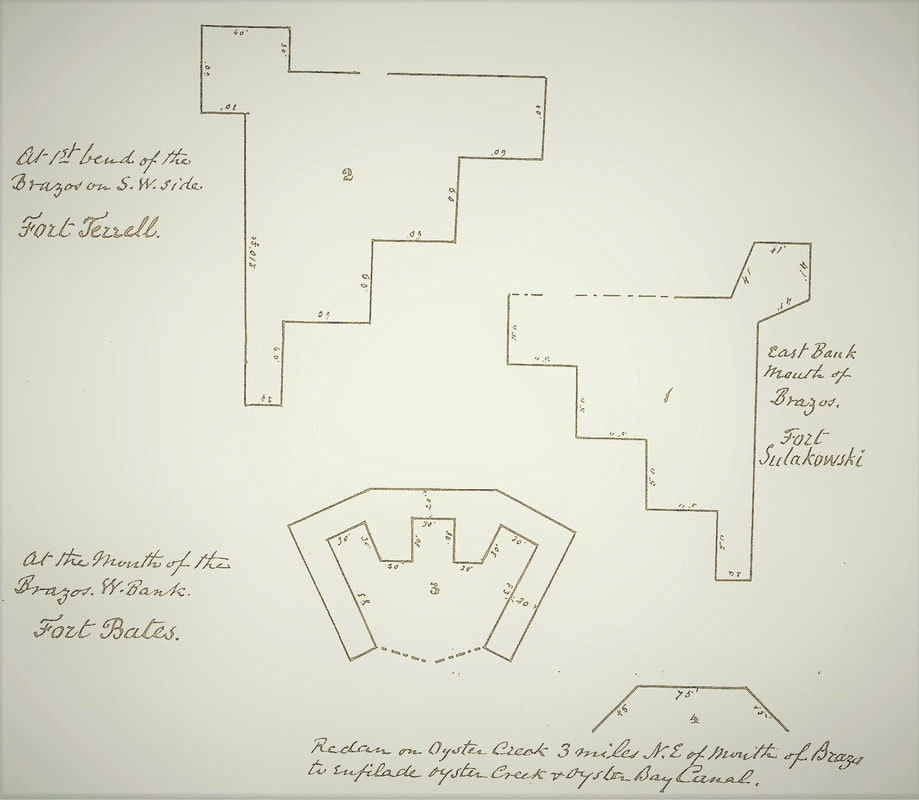The Forts Velasco
Gone ... But, No Longer Lost to History
The original Fort Velasco was built at the mouth of the Brazos River in southeast Texas by soldiers and officers of the Mexican military in 1832, to enforce customs and immigration provisions of the Law Of 6-Apr-1830, passed by the Mexican federal legislature on that date. Over the prior decade, the Brazos had been used a key port of entry for the empresario grant of Stephen F. Austin (known as Austin's Colony), although only minor development had occurred at the mouth of the river by 1832. Other later forts were also built at this strategic spot, and the town of old Velasco grew up around this location beginning in the mid-1830's. These later forts (also named Fort Velasco) were built during the Texas Revolution and the Civil War.
This website presents some recent research for the several Forts Velasco, once built in an area now at Surfside Beach, Texas in or near the location of Surfside Jetty Park of the Brazoria County Parks Department. The research has emphasized first-hand or contemporaneous accounts (primary documents), and are displayed for educational purposes on other web pages of this site. A lengthy narrative report is also available, by clicking on the thumbnail below:
Gone ... But, No Longer Lost to History
The original Fort Velasco was built at the mouth of the Brazos River in southeast Texas by soldiers and officers of the Mexican military in 1832, to enforce customs and immigration provisions of the Law Of 6-Apr-1830, passed by the Mexican federal legislature on that date. Over the prior decade, the Brazos had been used a key port of entry for the empresario grant of Stephen F. Austin (known as Austin's Colony), although only minor development had occurred at the mouth of the river by 1832. Other later forts were also built at this strategic spot, and the town of old Velasco grew up around this location beginning in the mid-1830's. These later forts (also named Fort Velasco) were built during the Texas Revolution and the Civil War.
This website presents some recent research for the several Forts Velasco, once built in an area now at Surfside Beach, Texas in or near the location of Surfside Jetty Park of the Brazoria County Parks Department. The research has emphasized first-hand or contemporaneous accounts (primary documents), and are displayed for educational purposes on other web pages of this site. A lengthy narrative report is also available, by clicking on the thumbnail below:
|
Industry is Fortune's Right Hand - a sentiment expressed by Mary Austin Holley in "Texas. Observations, Historical, Geographical and Descriptive", 1833, p. 45 |
Dios y Libertad (God and Liberty) - a customary closing salutation found in Spanish-language letters of this era |
Where Light is, There is Liberty - Where Liberty Dwells, There is my Country.
- motto of the Texas Gazette in 1830-1831, found in "Texas Gazette, 1829-1831", SWHQ, 56 (2), Oct-1952, p. 245
- motto of the Texas Gazette in 1830-1831, found in "Texas Gazette, 1829-1831", SWHQ, 56 (2), Oct-1952, p. 245
The remainder of this website is intended to show a few interesting episodes of this history, including some of the key primary documents that help tell the story, and are obscure or not readily available elsewhere. The episodes can be viewed by clicking on the "MORE..." button in the upper right corner, or by sequentially clicking on the links at the bottom of each page. Links to the full report can also be found near the bottom of each subsequent page. Underlined words or phrases are live links to outside web pages, where more details can be found on the subject.
|
As the 1830’s dawned in southeast Texas, significant but mostly rural settlement had been underway for almost a decade in this previously undeveloped area of Mexican Texas, largely through the colony established by Stephen Fuller Austin known as Austin’s Colony, with his original settlers known as the Old Three Hundred. The only towns of note were San Felipe de Austin, Brazoria, Matagorda and Harrisburg, each only a few years old. The area at the mouth of the Brazos was a key port of entry for Austin’s Colony, but the adjacent low “salt flats” were mostly barren of fresh water, timber and game, vulnerable to tides and storms, and only a few settlers chose to eke out an existence there. However, in the next few years, major developments in the history of Texas would occur here, primarily due to its strategic location for transportation, military and commercial purposes. Alarmed by Austin’s success at colonization, the Mexican national government chose to establish a customs post at the location, soon joined by a small military fort initially named as “Fortaleza de Velasco”, which later gave its name to the area. The towns of Quintana and Velasco developed on either side of the mouth of the Brazos River in the 1830's. |
|
Although there were attempts to establish a customhouse at the mouth of the Brazos River in 1830 and again in 1831, these efforts were less than fully successful, so the first Fort Velasco was built in the spring of 1832 to enforce the new law. Soon after its construction, this fort was the site of a skirmish called the Battle Of Velasco, sometimes memorialized as the “first battle of the Texas Revolution” or its version of the “Boston Tea Party” or “Lexington and Concord”, after which the fort was largely abandoned. It consisted of two concentric and circular palisade walls (the annular area being partially filled with sand), and a central sand bastion with a wooden parapet, mounting one long 8- or 9-pound cannon. Buildings such as a customhouse, barracks, office and other structures were probably present both inside and outside the fort. |
|
During the Texas Revolution in late 1835 and early 1836, a new Fort Velasco was constructed by the Texas Revolutionary Army. After the Battle of San Jacinto, the government of the new Republic of Texas met at Velasco until Oct-1836, since this fort and the new robust Texas Navy afforded them protection, and the emerging town of Velasco offered them modest but best-available accommodations. Many other of the few small towns in Texas had burned in the Runaway Scrape of the Revolution. A diagram was found in the Nacogdoches Archives (to the left) which appears to be a drawing made for this fort. At least until 1840, this fort was manned by the Army of the Republic Of Texas, fortified by four cannon (one of which was an 18-pounder). |
|
There were also two forts built at the time of the American Civil War at Velasco, and each was also known as Fort Velasco. In fact, several large forts were built in the Quintana and Velasco areas by Jan-1864, as shown in a report by the supervisor of their construction, Lt. Abram Cross (right): 1 - Fort Sulakowsi at Velasco (aka Fort Velasco) 2 - Fort Terrell about a mile upstream on Quintana side 3 - Fort Bates at Quintana 4 - a small redan (a projecting embankment) on Oyster Creek at the Bay Canal Please see subsequent pages for more details on the creation of the ports and forts at Velasco. |
click for other pages > The "Port of Galvezton" at the Brazos? >>>
Background wallpaper is from 1836 version of "Map of Texas - With Parts of the Adjoining States" by Stephen F. Austin, printed by H. S. Tanner of Philadelphia
Please communicate errors or issues with website using the CONTACT page. Thanks!
Copyrighted materials included within this website are in accordance with Title 17 U.S.C. Section 107 related to Copyright and “Fair Use”, which permits use of copyrighted materials to further scholarship, education, and inform the public. We intend to conform to the principles of fair use and to comply with copyright law, so if there is any issue, please let us know via the CONTACT page.
Background wallpaper is from 1836 version of "Map of Texas - With Parts of the Adjoining States" by Stephen F. Austin, printed by H. S. Tanner of Philadelphia
Please communicate errors or issues with website using the CONTACT page. Thanks!
Copyrighted materials included within this website are in accordance with Title 17 U.S.C. Section 107 related to Copyright and “Fair Use”, which permits use of copyrighted materials to further scholarship, education, and inform the public. We intend to conform to the principles of fair use and to comply with copyright law, so if there is any issue, please let us know via the CONTACT page.

For those who have some fluency in Spanish, we can use some help in completing and improving the transcriptions and translations of some of the primary documents
- so please have a look!
Please use CONTACT page to open communication.
In many cases, higher-resolution copies of originals can be provided.
Such documents can be found via links at the bottom of theses sub-pages:
Seizure of Schooner Cañon Suspension of "Aduana Maritima de Galvezton" Creation of First Fort Velasco The Battle of Velasco Barranco Colorado
- so please have a look!
Please use CONTACT page to open communication.
In many cases, higher-resolution copies of originals can be provided.
Such documents can be found via links at the bottom of theses sub-pages:
Seizure of Schooner Cañon Suspension of "Aduana Maritima de Galvezton" Creation of First Fort Velasco The Battle of Velasco Barranco Colorado












